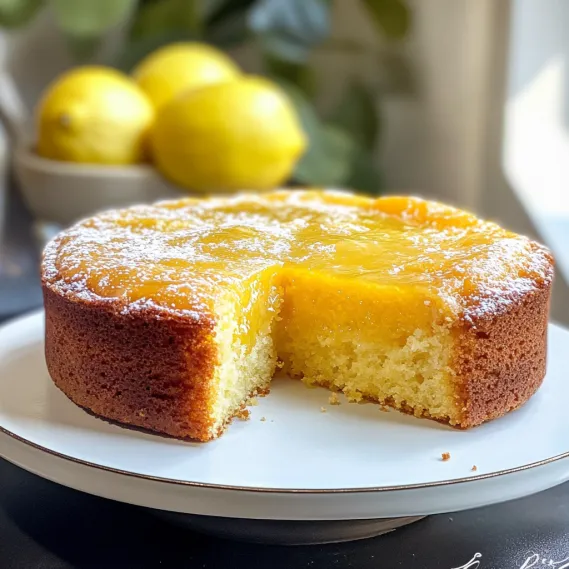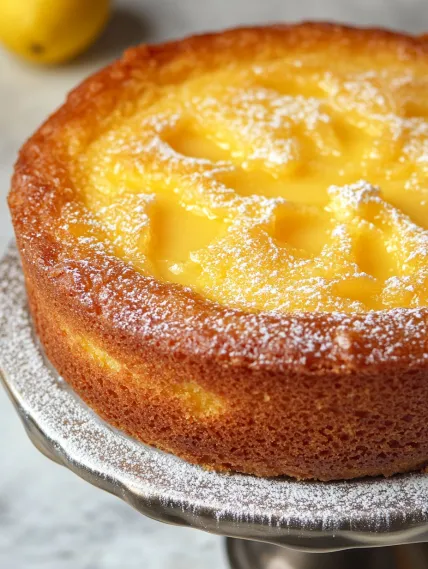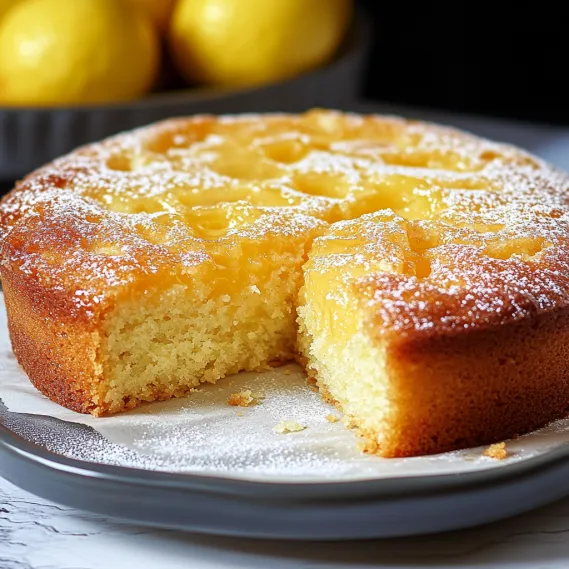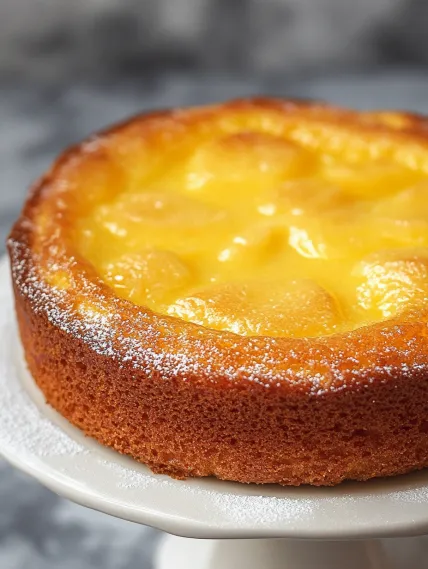 Pin
Pin
This sweet and super lemony gooey cake is sure to impress everyone with its bright citrus flavor and moist, tender texture. What makes this cake truly special is the generous amount of lemon curd both mixed into the batter and dolloped throughout the cake, creating pockets of tangy sweetness in every bite. With just a handful of simple ingredients and straightforward preparation, you'll have a showstopping dessert that perfectly balances sweetness with vibrant lemon zing. It's the perfect treat to welcome spring or brighten any day of the year.
I've always had a deep appreciation for lemons in both sweet and savory cooking. There's something magical about the way their bright acidity can transform a dish from bland to brilliant with just a few drops. This lemon curd cake has become my signature dessert for springtime gatherings and afternoon tea with friends. The first time I served it at a garden party, three different guests asked for the recipe before they'd even finished their slices!
Essential Ingredients and Selection Tips
- All-Purpose Flour: Creates the perfect structure for this cake. Be sure to measure correctly by spooning into measuring cups and leveling off for best results.
- Baking Powder: Provides just the right amount of lift. Check for freshness by putting a teaspoon in hot water - it should bubble vigorously if active.
- Butter: Use good quality butter at room temperature for the best texture and flavor. Either salted or unsalted works well in this recipe.
- Eggs: Large eggs at room temperature incorporate more evenly into the batter, creating a smoother texture.
- Lemon Curd: The star ingredient! Use a high-quality store-bought version or make your own for even more vibrant flavor.
The quality of your lemon curd makes all the difference in this cake. I've found that homemade lemon curd creates the most vivid flavor, but a good quality store-bought version works beautifully too. Look for one with a bright yellow color and pronounced lemon taste rather than one that's overly sweet.
Detailed Cooking Instructions
- Step 1: Prepare For Success
- Preheat your oven to 350°F (180°C) and prepare an 8-inch round cake pan by lining it with parchment paper or generously greasing with butter. Taking time with this step ensures your cake will release easily after baking, preserving its beautiful appearance.
- Step 2: Mix The Dry Ingredients
- In a medium bowl, whisk together 1½ cups all-purpose flour, 1½ teaspoons baking powder, and ¼ teaspoon salt until well combined. This even distribution of leavening agents ensures your cake will rise evenly. Set aside while you prepare the wet ingredients.
- Step 3: Create A Fluffy Base
- In a large bowl, beat ¾ cup granulated sugar with ½ cup room temperature butter until light and fluffy, about 2-3 minutes. Add 2 large eggs one at a time, beating well after each addition until fully incorporated. Mix in half (about ¼ cup) of the lemon curd until the batter is smooth and creamy.
- Step 4: Combine With Care
- Gently fold the flour mixture into the wet ingredients using a spatula, mixing just until no dry streaks remain. Over-mixing can develop too much gluten, resulting in a tough cake, so use a light hand during this step. Spoon the thick batter into the prepared cake pan, spreading it evenly.
- Step 5: Create Lemon Curd Pockets
- Drop teaspoonfuls of the remaining lemon curd (about ¼ cup) randomly over the top of the cake batter. Use the tip of a knife to lightly swirl it in places, creating beautiful pockets of lemon goodness throughout the cake. Bake for 40 minutes or until the top is golden brown and a toothpick inserted in the center comes out with moist crumbs.

My first attempt at this cake taught me a valuable lesson about patience - I tried to remove it from the pan while still warm and ended up with a delicious but messy pile of cake! Now I always let it cool completely in the pan, which allows the structure to set properly around those lovely pockets of lemon curd.
The Perfect Texture Balance
The magic of this cake lies in its contrasting textures - tender cake surrounding pockets of smooth, almost pudding-like lemon curd. Through extensive experimentation, I've found that the key to achieving this perfect balance lies in three crucial elements. First, room temperature ingredients ensure proper emulsification and a smoother, more even batter. Second, careful folding of the dry ingredients maintains air bubbles for lightness. Finally, the dolloping technique for the lemon curd creates those delightful pockets that make every bite slightly different. My neighbor attempted this recipe but mixed all the lemon curd directly into the batter, missing out on those distinctive pockets of tangy sweetness that make this cake so special.

Seasonal Serving Suggestions
While this cake is delicious year-round, I particularly love adapting it to highlight seasonal offerings. In spring, I garnish with fresh berries and edible flowers for a garden-inspired presentation. During summer, a side of macerated strawberries creates a perfect pairing. In fall, a sprinkle of cinnamon in the batter adds warmth that complements the bright lemon flavor beautifully. Winter holidays call for a more elaborate presentation - I dust the top with confectioners' sugar using a paper snowflake as a stencil, creating a festive design that delights dinner guests. The versatility of this simple cake makes it appropriate for any occasion throughout the year, from casual brunches to elegant dinner parties.
Perfect Pairing Suggestions
The bright acidity of this lemon cake makes it particularly well-suited to thoughtful beverage pairings. I find that Earl Grey tea, with its bergamot notes, creates a harmonious flavor combination that enhances both the tea and the cake. For coffee drinkers, a light roast with citrus undertones complements rather than overpowers the delicate lemon flavor. When serving as a dessert after dinner, a glass of Prosecco or other sparkling wine creates a celebratory pairing, with the bubbles and acidity balancing the cake's sweetness. For non-alcoholic options, a sparkling water with a twist of lemon provides refreshing contrast. The clean, bright flavors of this cake make it versatile enough to serve with almost any beverage.
Troubleshooting Common Issues
After making this cake dozens of times, I've encountered and solved several common problems. If your cake is browning too quickly but still raw in the center, loosely tent it with aluminum foil after the first 25 minutes of baking. If your lemon curd sinks to the bottom, it may have been too cold when added - try letting it come to room temperature first. For cake that seems too dense, check the freshness of your baking powder and be careful not to overmix after adding the flour. If your cake develops large air pockets during baking, tap the filled pan gently on the counter a few times before baking to release any large air bubbles. And remember that this cake is meant to be slightly gooey in the center - it's not a traditional sponge cake, so embrace its pudding-like qualities!

This Best Lemon Curd Cake has become my signature dessert, the one friends and family request most often. What began as a simple experiment with my love of lemons has evolved into a beloved recipe that I've shared countless times. There's something deeply satisfying about creating a dessert that perfectly balances sweetness with bright acidity, creating a taste experience that feels simultaneously indulgent and refreshing. When life gives you lemons, don't just make lemonade - make this cake and watch as it becomes your most requested recipe too!
Recipe FAQs
- → Can I use homemade lemon curd for this cake?
- Absolutely! While store-bought lemon curd works perfectly fine, homemade lemon curd can elevate this cake even further with its fresh flavor. If making your own, prepare it at least a few hours ahead or the day before so it has time to cool and thicken properly. You'll need about 1½ cups of lemon curd for this recipe.
- → How do I know when the cake is done baking?
- This cake is a bit tricky to test for doneness because of its intentionally gooey texture. The top should be golden brown, and a toothpick inserted into the cake part (not in a lemon curd pocket) should come out mostly clean with a few moist crumbs. The cake will still have some jiggle, especially in the center, due to the melted lemon curd inside. It will continue to set as it cools.
- → Can I make this cake ahead of time?
- Yes, this cake can be made 1-2 days ahead of time. Once completely cooled, store it in an airtight container at room temperature for up to 24 hours or in the refrigerator for up to 3 days. If refrigerated, bring to room temperature before serving for the best texture and flavor. Add the confectioners' sugar dusting just before serving for the prettiest presentation.
- → Why did my cake sink in the middle?
- Some sinking is normal for this cake as it cools, especially in the areas with concentrated lemon curd. The cake rises during baking, but as it cools, the gooey parts naturally settle. This is part of its charm! For less sinking, you can try baking it a few minutes longer, but be careful not to overbake and lose the delicious gooey texture that makes this cake special.
- → Can I freeze this lemon curd cake?
- Yes, you can freeze this cake. Once completely cooled, wrap it well in plastic wrap and then aluminum foil, or place in an airtight container. Freeze for up to 3 months. Thaw overnight in the refrigerator or for several hours at room temperature before serving. The texture might change slightly after freezing, but it will still be delicious.
- → What can I serve with this lemon curd cake?
- This cake is wonderful on its own, but for special occasions, consider serving it with a dollop of lightly whipped cream, a scoop of vanilla ice cream, or some fresh berries (particularly raspberries or blueberries, which pair beautifully with lemon). For an extra lemon touch, you could also serve additional warmed lemon curd on the side for those who can't get enough of that tangy flavor.
